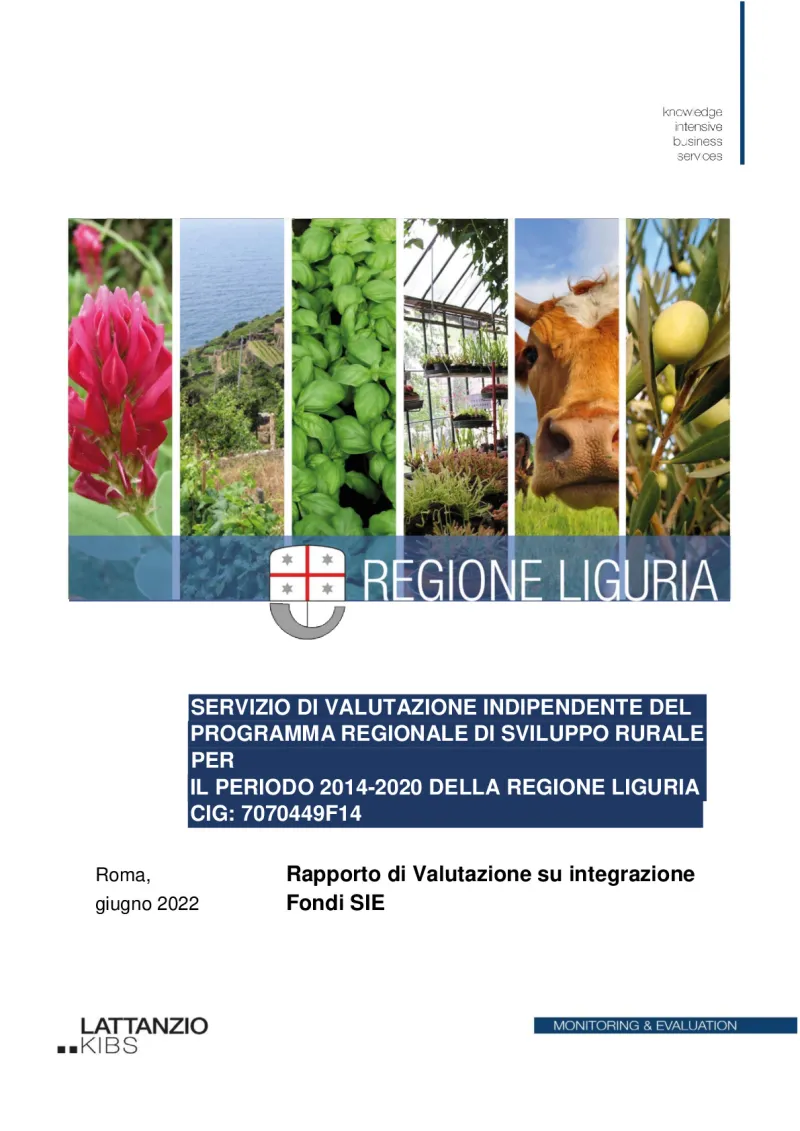Evaluation report on the integration of ESI funds for the Liguria region
- Evaluation
- Long-term Vision for Rural Areas
- Jobs, Growth and Equality in Rural Areas
- Environment
- Agricultural Productivity
- Climate and Climate Change
- Evaluation
- Fostering Knowledge & Innovation
The report assessed the specific areas of integration and complementarity between the European Regional Development Fund (ERDF) and European Agricultural Fund for Rural Development (EAFRD) by analysing the progress made in ensuring an integrated approach to using the latter.
- Italy
- 2014-2022
- Socio-economic impacts


The evaluation, published in 2022, is carried out in the framework of the independent evaluation service of the Liguria region's 2014-2020 Rural Development Programme (RDP).
The objective of the evaluation is to analyse and assess the specific areas of integration/complementarity between the EAFRD and ERDF. In particular, the thematic report analyses the progress made in ensuring an integrated approach to using the EAFRD. Evidence is given on the contribution of the European Structural and Investment Funds (ESI) to the following policy areas: National Strategy for Inner Areas (NSIA), access to ICT and improvement of service infrastructures, promotion of innovation and integration of the interventions promoted by the Liguria RDP with other initiatives financed by the EU.
Regarding the methodological approach, in addition to documentary analysis, the evaluation relies on information gathered through interviews.
The evaluation concluded that the integration of the EAFRD into the NSIA did not occur according to a unitary guideline and followed highly varied implementation arrangements that depend on regional contexts. In general, the reference at the implementation stage to generic calls, which are not targeted to the intervention needs of areas, often led to a mismatch between the requests of the territories and the capacity of the programme to provide adequate responses.
However, NSIA is a tool that stimulates the dialogue necessary for an inclusive and effective design. It is also the instrument through which the ESI can work in synergy beyond thematic differences because they are applied to a 'place-based' policy. The complementarity of the funds is ensured by the programming instruments adopted, ITI (integrated territorial investments), community-led local development (CLLD) and the unitary implementation instrument.
Concerning access to ICT and improvement of service infrastructures for the population and businesses, the evaluation concluded that the complementarity between the EAFRD and ERDF expects the replication of the integration model adopted for the 2007-2013 programming period. In particular, the ERDF and the EAFRD allocate a considerable share of resources to achieve full coverage of the digital divide.
Complementarity between funds is ensured through different and autonomous initiatives aimed at pursuing the same purpose. Objectives are expressed in different output indicators, while the RDP's Measure 7.3 aims to reach a certain percentage of the rural population benefiting from new or improved services and infrastructure (ICT). The ERDF also operates in rural municipalities carrying out interventions in close connection and in complementarity with those financed under the 2014-2020 RDP. The action, therefore, has a dual objective to improve the access conditions to the ultra-broadband network in critical areas (coverage and market conditions) and to develop ICT by creating the conditions for the emergence of new businesses in the region.
Concerning the promotion of innovation, the report concludes that complementarity with the ERDF mainly relates to 'thematic objective 1' of the National Partnership Agreement. Concerning research and development interventions, the ERDF supports enterprise networks, clusters and networks with research and innovation bodies to support companies in developing more innovative products, processes and services.
The contribution of programmes to implementing the regional strategy for smart specialisation was difficult to assess, especially since programming documents and implementation did not include specific references to the strategy. Despite this, EAFRD still intervenes in achieving the innovation objectives set by the strategy and complements ERDF interventions. As the analysis showed, RDP concentrates its resources on technological transfer and experimentation interventions by implementing cooperation and pilot projects under Measure 16. In particular, by strengthening the quality of agri-food products and promoting the ability to network between small operators, micro-enterprises and research institutions in the Ligurian agricultural production sector.
Finally, the evaluation concludes that projects funded through the Interregional Cooperation Programme INTERREG EUROPA make it possible to overcome traditional approaches and take advantage of an opportunity to exchange good practices between different institutions, including non-profit organisations, public-law companies and businesses.
Although investment is not financed, membership in territorial cooperation projects can complement the structural funds by exploiting and financing communication, exchanging experience, training, etc.
Concerning LIFE projects, the activities carried out for wolves have already made it possible to support RDP measures in the 2014/2020 programming period. A particularly interesting link is between financing preventive structures with agri-environmental commitments linked to farmers' eco-sustainable management of pastures. Moreover, integration between the LIFE WOLFALPS project and the actions promoted by the RDP can become a resource for attracting tourism and enhancing local products.
Author(s)
LATTANZIO KIBS